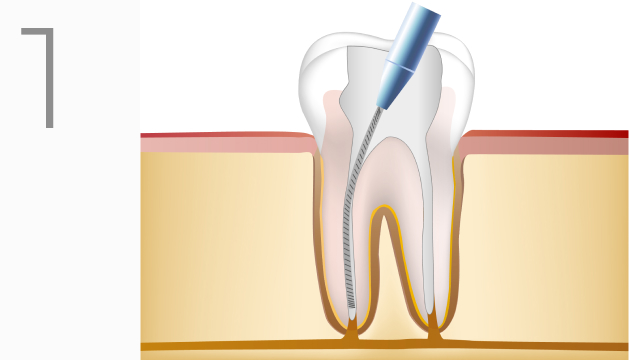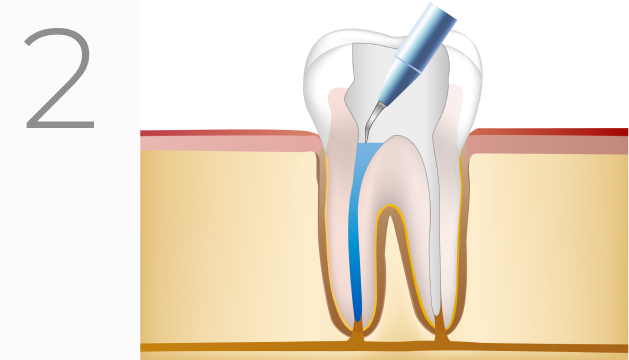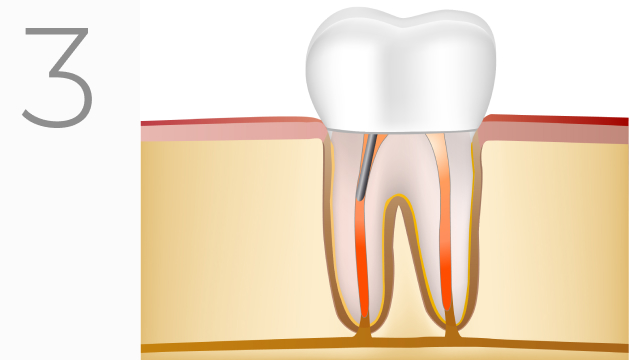Root Canal Treatment
Whose knees do not quake at the thought of a “root canal?” Pain and cost spring to mind.

One of the great fears about a root canal treatment is that it will be very painful. The actual procedure itself is relatively painless. The pain a patient feels is actually a result of the infection and inflammation, not from the treatment itself. The truth is: the treatment itself does not cause pain; it helps to alleviate it. The dentist will prevent any discomfort during the procedure by numbing the tooth and the surrounding area with local anesthesia.
Another common concern: treatment is expensive. Yes, it is not cheap, but it is a less costly option than having the entire tooth removed and then replaced with an implant or bridge.
What Is A Root Canal?
The commonly used term “Root Canal” is not a treatment itself, but part of a tooth. It is the hollow part of a tooth that contains the nerve, blood vessels & other tissue, collectively known as the pulp. And when this inner tooth content becomes infected and inflamed, root canal treatment is performed to remove it. In dentistry we call it endodontic treatment. This process also protects the tooth from future decay and prevents infection spread to the bone and surrounding tissues.
What Are The Three Steps Of A Root Canal Procedure?

Cleaning The Root Canal
First, the dentist evacuates everything from inside of the root canal. After numbing the tooth, the dentist makes a small access hole on the surface of the tooth & removes the diseased & dead pulp tissue using delicate files.

Filling The Root Canal
The dentist cleans, shapes & decontaminates the new hollow area, using tiny files & irrigation solutions to thoroughly remove all diseased matter. Once this part is complete, the tooth is filled with a rubber-like material, using an adhesive cement to seal the canals completely.

Adding A Crown Or Filling
Having removed the infected material, the tooth will now be more fragile. A tooth with no pulp must now receive its nourishment from the ligament that attaches it to the bone. This blood supply is adequate, but in time, the tooth will become more brittle, so a crown or filling offers the much-needed protection.
A root canal treatment often takes only one appointment. But if we have to treat a tooth with multiple or curved root canals, or tooth inflammation is severe, more appointments might be needed.

After a root canal treatment you might feel some tenderness, which is normal. This is temporary & over-the-counter pain medications are usually enough to relieve it. If needed, prescription pain medications, such as codeine, are available. The dentist may also prescribe an antibiotic to treat an infection.
Some patients opt for tooth extraction, especially if the tooth cannot be restored. For example, if there is a large amount of decay, trauma, or bone loss due to periodontal or gum disease. However, in the majority of cases, a root canal treatment will save the tooth & eliminate the pain.
You might look for a tooth extraction as an alternative option for endodontic treatment (root canal treatment) with subsequent tooth crown placement. But tooth implant or bridge placement to replace the removed tooth is more expensive. We know, and it was proven scientifically, that people with their own teeth live longer. So, we do everything in our power to save your teeth and avoid unnecessary extractions. And if the missing tooth is not replaced, it can eventually lead to adjacent teeth shifting and more dental problems.
